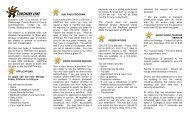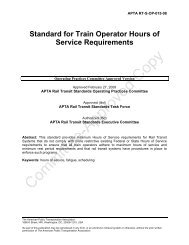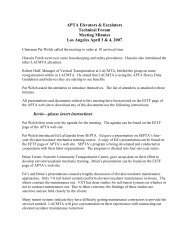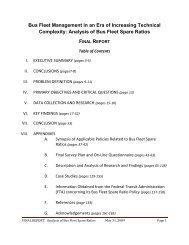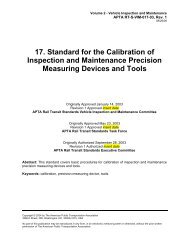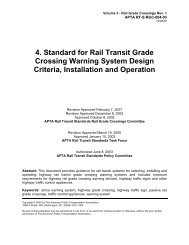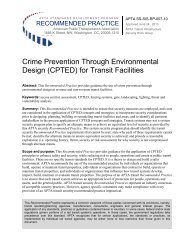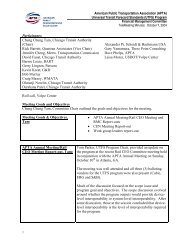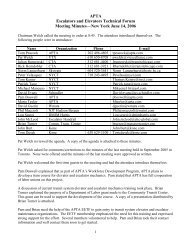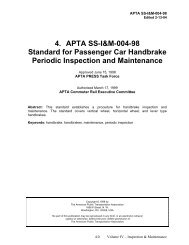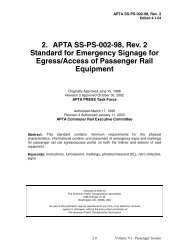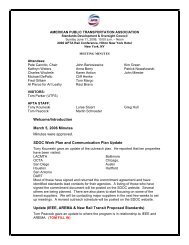Standard Bus Procurement Guidelines - APTAStandards.com
Standard Bus Procurement Guidelines - APTAStandards.com
Standard Bus Procurement Guidelines - APTAStandards.com
You also want an ePaper? Increase the reach of your titles
YUMPU automatically turns print PDFs into web optimized ePapers that Google loves.
<strong>Standard</strong> <strong>Bus</strong> <strong>Procurement</strong> <strong>Guidelines</strong><br />
Baseline: No<br />
requirement<br />
for an<br />
automatic<br />
engine<br />
shutdown<br />
feature.<br />
Alternative: Automatic Engine Shutdown.<br />
The engine control system shall shutdown the engine automatically when<br />
parameters established for critical functions are exceeded. The on-board<br />
diagnostic system, as described in Section 5.4.6.1.6, shall trigger a visual and<br />
audible alarm to the operator when the engine control unit detects a<br />
malfunction and the engine shutdown system is activated. Automatic<br />
shutdown shall only occur when parameters established for the functions<br />
checked below are exceeded:<br />
Coolant Level<br />
Coolant Temperature<br />
Oil Pressure<br />
Oil Temperature<br />
Intake Manifold Temperature<br />
Baseline: No<br />
requirement for an<br />
automatic engine<br />
shutdown override<br />
feature.<br />
5.2.2.1.2 Cooling Systems<br />
Alternative: Automatic engine shutdown<br />
override.<br />
A control shall be available to the operator,<br />
allowing him/her to allow override of the<br />
engine shutdown system if engine power is<br />
required to move the bus in emergency<br />
conditions. If both override alternatives are<br />
selected (i.e., Automatic Engine Protection<br />
and Automatic Engine Override), a single<br />
override control may be used.<br />
Temperature of operating fluids and intake air shall be controlled by independent cooling system<br />
controls. The cooling systems shall be of sufficient size to maintain all engine and transmission fluids<br />
and engine intake air at safe, continuous operating temperatures during the most severe operations<br />
possible and in accordance with engine and transmission manufacturers’ cooling system requirements.<br />
The cooling system in new condition shall have an ambient capacity of at least 110ΕF with water as<br />
coolant and sea level operation. with the bus loaded to GVWR and with ambient temperatures up to<br />
115Ε F.<br />
5.2.2.1.2.1 Engine Cooling<br />
The engine shall be cooled by a water-based, pressure type, cooling system that does not permit boiling<br />
or coolant loss during the operations described above. Engine thermostats shall be easily accessible for<br />
replacement. Shutoff valves shall allow filter replacement without coolant loss. Valves shall permit<br />
<strong>com</strong>plete shutoff of lines for the heating and defroster units, and water booster pumps. All low points in<br />
the water-based cooling system shall be equipped with drain cocks. Air vent valves shall be fitted at<br />
high points in the cooling system unless it can be demonstrated that the system is self-purging.<br />
Technical Specifications 135 10/18/07



